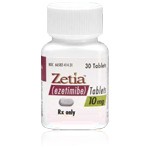Understanding High Lipid Levels in the Blood and Their Impact on Health


Lipids, a broad category of molecules that includes fats, oils, and cholesterol, play vital roles in the body, such as energy storage, cellular function, and hormone production. However, when lipid levels in the blood become elevated, it can lead to serious health risks, including cardiovascular diseases. In this article, we will explore the effects of high lipid levels in the blood, the causes behind this condition, the potential dangers it poses, and the role of Zetia (ezetimibe) in managing high cholesterol and lipid levels.
What Happens When Lipids Are High in the Blood?
Lipids are essential for various bodily functions, but their concentration in the blood needs to remain balanced. When lipid levels become elevated, particularly cholesterol and triglycerides, they can contribute to the buildup of fatty deposits in the walls of arteries, a process known as atherosclerosis. This buildup can reduce the blood flow to vital organs, including the heart and brain. Over time, this can lead to serious conditions like coronary artery disease, stroke, and heart attacks.
High lipid levels can also lead to the development of fatty liver disease, where excess fat accumulates in the liver, potentially impairing its function and leading to liver inflammation or cirrhosis if left untreated.
In addition to physical blockages, high lipid levels can also affect blood pressure. When arteries become narrow or hardened due to fat deposits, the heart has to work harder to pump blood through the body, which can result in increased blood pressure.
What Causes High Lipid Levels in the Blood?
Several factors can contribute to high lipid levels in the blood, with lifestyle choices playing a significant role. Some of the most common causes include:
- Diet: Consuming foods that are high in saturated fats, trans fats, and cholesterol can raise the levels of harmful lipids in the blood. These foods include fatty cuts of meat, full-fat dairy products, and processed foods that contain hydrogenated oils.
- Obesity: Excess weight, especially abdominal fat, is a major risk factor for high lipid levels. Obesity can increase the levels of both cholesterol and triglycerides in the blood, making it harder for the body to maintain a healthy balance.
- Lack of Physical Activity: Regular physical activity helps regulate lipid levels by increasing high-density lipoprotein (HDL) cholesterol, often referred to as "good" cholesterol, while reducing low-density lipoprotein (LDL) cholesterol, known as "bad" cholesterol. A sedentary lifestyle contributes to poor lipid regulation.
- Genetics: Some individuals inherit conditions like familial hypercholesterolemia, where the body produces high levels of cholesterol, leading to elevated lipid levels in the blood. This genetic predisposition can make it harder to control lipid levels even with a healthy diet and exercise.
- Medical Conditions: Certain diseases and conditions, such as diabetes, hypothyroidism, kidney disease, and liver disease, can contribute to high lipid levels. These conditions may interfere with the body’s ability to metabolize lipids properly.
- Medications: Some medications, including certain types of birth control, steroids, and diuretics, can lead to higher lipid levels in the blood. It's important for individuals on these medications to regularly monitor their lipid profiles.
- Age and Gender: As individuals age, their cholesterol levels tend to rise. Moreover, before menopause, women tend to have lower cholesterol levels than men, but after menopause, women’s cholesterol levels often increase, bringing them in line with those of men.
What Happens If There Are Too Many Lipids in the Body?
When there is an excessive amount of lipids, particularly cholesterol and triglycerides, in the body, it can have a number of detrimental effects. Cholesterol is necessary for building cell membranes, but too much of it, especially LDL cholesterol, can lead to plaque formation in the arteries, which can lead to:
- Coronary Artery Disease: This condition occurs when the coronary arteries, which supply blood to the heart, become blocked by fat deposits. It increases the risk of chest pain (angina), heart attacks, and heart failure.
- Stroke: If the blood flow to the brain is reduced or blocked due to plaque buildup in the arteries, it can lead to a stroke, which occurs when brain cells are deprived of oxygen and nutrients.
- Peripheral Artery Disease (PAD): The accumulation of lipids in arteries can reduce blood flow to the limbs, especially the legs. This can lead to pain, weakness, and difficulty walking, and in severe cases, can lead to tissue death.
- Pancreatitis: Very high levels of triglycerides can lead to inflammation of the pancreas, known as pancreatitis. This condition is often accompanied by severe abdominal pain and can be life-threatening if not treated promptly.
- Fatty Liver Disease: When excessive lipids build up in the liver, it can lead to fatty liver disease, which can impair liver function. In some cases, this can progress to cirrhosis, liver failure, or liver cancer.
What If Total Lipids Are High?
Total lipids refer to the sum of all types of fats in the blood, including cholesterol and triglycerides. High total lipid levels can signify an imbalance between different types of fats in the body, which may not only increase the risk of cardiovascular diseases but also disrupt other bodily functions.
When total lipid levels are high, it’s essential to assess the levels of specific lipids, such as:
- LDL Cholesterol (Low-Density Lipoprotein): Often referred to as "bad" cholesterol, high levels of LDL cholesterol can contribute to the formation of fatty plaques in the arteries. It’s a primary contributor to atherosclerosis.
- HDL Cholesterol (High-Density Lipoprotein): Known as "good" cholesterol, HDL helps remove LDL cholesterol from the bloodstream. High HDL levels are beneficial, as they help protect against heart disease.
- Triglycerides: Elevated triglycerides are associated with an increased risk of heart disease and other metabolic conditions. High triglyceride levels can result from a high-fat diet, obesity, excessive alcohol consumption, or poorly controlled diabetes.
A comprehensive evaluation of total lipids, including the breakdown of each type, is crucial for understanding the individual’s overall lipid profile and identifying the specific areas of concern.
The Role of Zetia in the Treatment of High Lipid Levels
Zetia (ezetimibe) is a medication used to help lower cholesterol levels in individuals with high blood lipid levels, particularly those with high LDL cholesterol. It works by inhibiting the absorption of cholesterol from the small intestine. This reduces the amount of cholesterol that enters the bloodstream, which, in turn, helps lower total cholesterol and LDL levels.
Zetia is often prescribed in combination with statins, which are another class of drugs used to lower cholesterol by inhibiting cholesterol production in the liver. When used together, Zetia and statins can provide a more effective approach to managing high lipid levels, as they target different aspects of cholesterol regulation.
In addition to its role in lowering LDL cholesterol, Zetia may also be helpful in individuals who cannot tolerate statins due to side effects. It offers an alternative treatment option for controlling lipid levels and reducing the risk of cardiovascular events.
Zetia is typically well-tolerated, with common side effects including mild gastrointestinal discomfort or muscle pain. However, as with any medication, it is important for individuals to consult with their healthcare provider to ensure the appropriate treatment plan for their specific condition.
Conclusion
High lipid levels in the blood are a significant risk factor for cardiovascular diseases, stroke, and other serious conditions. A combination of unhealthy lifestyle choices, genetics, and underlying medical conditions can contribute to elevated lipid levels. When lipid levels, particularly LDL cholesterol and triglycerides, become too high, they can lead to plaque buildup in the arteries, reducing blood flow and increasing the risk of heart attack and stroke.
Managing high lipid levels involves a combination of lifestyle changes, such as improving diet, increasing physical activity, and, in some cases, using medications like Zetia. By understanding the causes, risks, and treatment options for high lipid levels, individuals can take proactive steps to protect their health and reduce their risk of cardiovascular disease. Regular monitoring and working closely with healthcare providers are essential in maintaining a healthy lipid profile and overall cardiovascular health.
Aricle Post:Editorial Team of RXShop.md
(Updated at Jul 7 / 2025)

